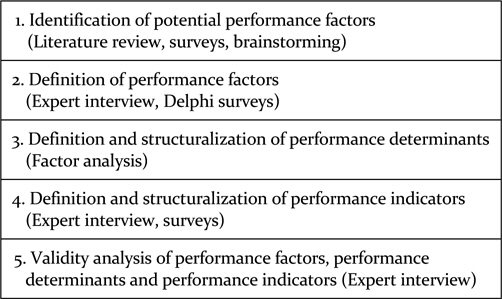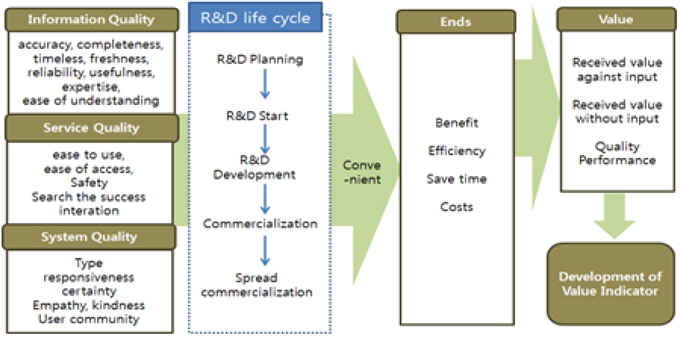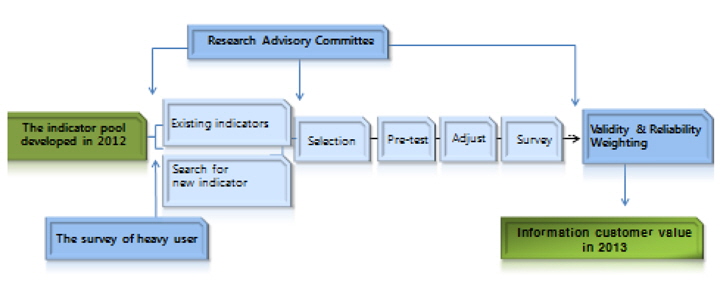


Knowledge, technology and information have special characteristics different from the ones of normal consumer products and services. Especially the value of such information varies according to external elements such as the provided environment, their method of utilization, and the level and purpose, etc. of the user. In this study, the indicators of information customer value are developed and measured to enhance customer-based values with efforts for making new customers and maintaining existing customers. The result is as follows: 14 customer value indicators were developed. Among the indicators, value gained versus effort, reduced time for research idea investigation and savings in time searching for equipment, and tools and materials got the highest score, which means that time-saving effects were the most important. The field study of this paper was conducted from information users in the field of national R & D, and thus future studies could be conducted in various industries in many countries to attain generalized results.
Knowledge, technology and information have special characteristics different from the ones of normal consumer products and services. The value of such information varies according to external elements such as the provided environment, their method of utilization, and the level and purpose, etc. of the user. Especially in the case of information furnished without any public institutions' charges, there are no monetary sacrifices. Therefore, the value can be considered as decision-making benefits or improvements to work productivity of customers. The reason why such customer-centric values are of great importance is because future competitive advantages in competitive industrial fields are being decided by customers’ orientation. Accordingly, corporations are seeking to enhance customer-based values with efforts to making new customers, maintaining existing customers, saving existing customers’ costs, increasing sales from customers, and doing it all based on customer values.
Research and investment in customer value management (CVM) is being analyzed academically and industrially. KISTI (Korea Institute of Science and Technology Information) developed the 108-item 'R&D Efficiency Indicators for the Joint Utilization of National R&D Information' (KISTI, 2012) to assess the information of customer value perceived by the users of national R&D information services from an R&D information marketing perspective. These indicators were developed to analyze, from an information customer value perspective, the efficiency of utilization of information by job researchers and research administrators. However, as the 108 indicators developed for detailed measurements represent an excessively huge number, their application in the field is indeed difficult. Therefore, there is a need to enhance the stability and suitability of these indicators by examining the possibility of integrating some by adding, adjusting and generalizing while modifying and improving the set to create a set of indicators more easily measurable and applicable in the field. Also, indicators must be scientifically and objectively measurable with above all else, sufficiently verified applicability, allowing for the systematic identification of the degree to which information utilization efficiency is enhanced. In this context, the purpose of this study is to verify the suitability of previously developed indicators and to identify the representative indicators among them and to apply these representative indicators to measure and assess the customer values of information users.
Ⅱ. Customer Values and R&D Information
Customer value is the general evaluation of the utility of a product by a customer based on perceptions of benefits and costs (Zeithaml, 1988). Anderson (1995) defined customer values as the perceived worth of monetary units of the economical, technological, service and social benefits gained in the process of the exchange between corporations and customers regarding the price paid for products and services. Woodruff (1997) defined customer value as a variable that promotes the realization of customer objectives and goals, which is the customer’s preference and attributes evaluation, performance and results of products and services as perceived from their use. That is, value marketing is performed by customer's subjective evaluation, and also customer value can be formularized as (output + process quality) / (price + service acquisition cost). Also, customer value means the essence of the relationship between the product and user. As it can be measured before, during, and after use of a product, and can be measured through simple ownership as well, considerations must be made with the characteristic attributes of a product or service, the results from the use of the product, and the final state as viewed by the customer. Also, the needs or desires that the customer fundamentally seeks to gain from a product or service must be reflected, along with the ideally desired values before purchasing the product. Customer value must have a future-oriented nature, regardless of the fundamental needs that are demanded regardless of a specific product or its supplier, and at the time when a service is used. Perceived value can be described as "what I have gained in exchange of what I have given up". From this perspective, customer value can be defined as the benefits gained relatively to the cost provided by a customer.
On the other hand, customer satisfaction is the response of a customer regarding the values gained from a product or service provided as well as the positive or negative emotions of a customer regarding the values gained as the result of using what is provided. Positive emotions mean satisfaction, while negative emotions mean dissatisfaction (Day, 1977). So customer satisfaction is determined by the obtained results relative to the expectations. In the process of comparing expectations and actual performance, when expectations are not matched in a negative way, dissatisfaction occurs, while when expectations are matched, satisfaction occurs.
Meanwhile, customer productivity is measured along the lines of a means-end hierarchy, and reflects the efficiency and effectiveness (professionalism) of the customer. Therefore customer productivity can be seen as a subset of customer value, which is a broader concept, and customer efficiency and effectiveness can be seen as potential preceding elements of customer value. Also, customer value indicates what the corporation should do, and customer satisfaction tells us how the corporation accomplishes customer value.
By interpreting customer value as the perception of customers as perceived in a certain users environment, customer value must be interpreted from the three perspectives of the purpose of consumption on the part of the user, the results of the use of a product, and the situation in which the product is used (Woodruff and Gardial, 1996).
Meanwhile, a distinction is made between customer satisfaction measurement (CSM) and customer value measurement (CVM). Customer satisfaction reviews specific attributes whereas value considers the purchase decision as a total package relative to other options (McLeod, 1999).
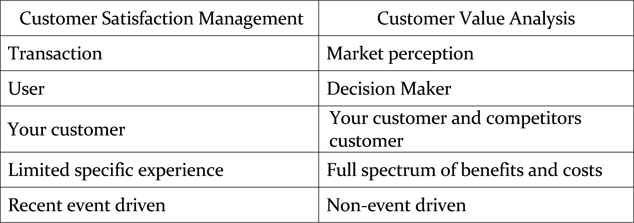
CSM and CVM
2. Measurement of Customer Value
Sweeney and Geoffrey (2001) used a scale with 19 items to empirically analyze the factor structure and discriminatory validity of perceived values in 4 categories. The 4 value categories were emotional value, social value, functional value I (price), and functional value II (performance), as shown in Table 2 below.
[Table 2] Customer value types
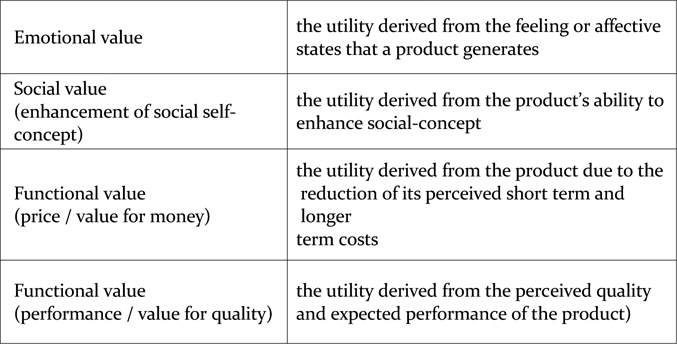
Customer value types
Existing literature on the measurement of customer value by other researchers is shown in Table 3.
[Table 3] Existing literature on the measurement of customer value
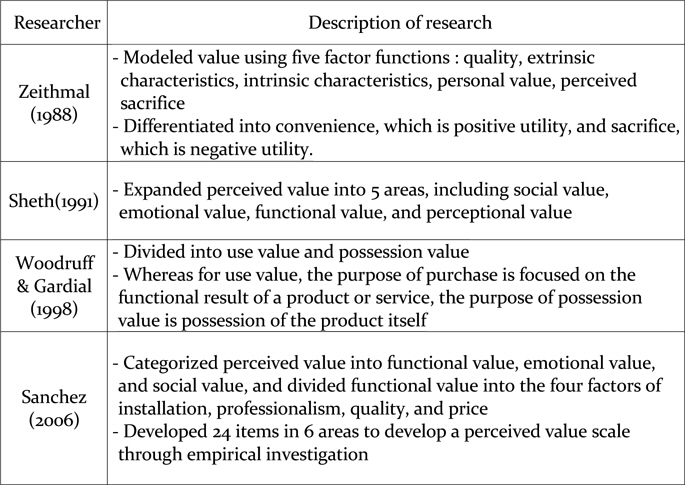
Existing literature on the measurement of customer value
3. Customer Value of Information
3.1 Definition and Characteristics of Information
Numerous scholars have defined information in various ways. McDonough (1963) defines information as 'data that evaluates value in a particular situation', treating the added value gained from data as information. Davis (1974) defined information as 'data processed in the form required by the person receiving it, which is realized in present or future decision-making, or whose value is acknowledged', adding that information makes it possible to know about value in decision-making situations or processes, and to achieve best results. Wiener (1956), famous for cybernetics brain engineering theory, defined information as “what humans exchange with the outside world when they act to adapt to it, or detect the results of regulatory behavior from it”. His definition sees information as the wisdom that aids humans in efficiently adapting to the environment. Also, Shannon (1948) said while A, B and C come to mind as situations that may now occur, it is not clear which of these will actually occur. He stressed the information function that reduces the uncertainty in this situation by some amount from a management and general social perspective.
That is to say that information is given value as information only after being analyzed, processed and organized according to a purpose. New value can be assigned according to the type and kind of information, and value of information. Therefore, information must be able to create new added value, and be a resource for reproduction.
Among the various definitions of information, three are relevant to information services. First, as a value-neutral definition, information is 'the transfer of what is known to man. This pertains to the function of 'providing information' on information services. Second, as a value-oriented definition, information is 'knowledge regarding facts, topics and events', and 'the transfer of educational knowledge'. Lastly, as a humanist and value-oriented definition, the function of information as education, training and advice is presented. That is, from the conceptual aspect of information and information services, in addition to providing information, both etymologically and conceptually include the human service functions such as educational properties, advice and counseling. Also, information services have a broad definition that is able to accommodate all social phenomena of contemporary times, including the development of computers and information technology with the advent of information society, digitalized information, online services and mobile technology.
Meanwhile, the value of information can be divided into commercial value, individual value and public value according to the purpose of use. First, commercial value means that information has become commercialized. That is, information is considered in value like commercial goods. Second, individual value is restricted to a very personal value, including the confidentiality of information. Included herein is the protection of information pertaining to oneself, in the form of patents or copyrights. Third, public value means that information impacts public welfare. Freedom of the press, freedom of expression, the freedom to access and use information, etc., are included herein.
Characteristics of information include time-limitedness, exclusiveness, usability, accumulated effectiveness and result-orientation. Information has the following characteristics that set it apart from normal consumer or goods service: 1) It can be created infinitely at low cost. 2) No depreciation with use. 3) Information services do not disappear when the service terminates, and can be saved. 4) Information accumulates with use. 5) Creation does not require much energy. 6) It can replace capital, labor and material resources. 7) It can be transported instantaneously over very long distances. 8) It has propagating properties. 9) More information is created as it is propagated. 10) The potential for sharing is infinite.
3.2 Information Customer Value
According to analyses by information economics, 'information' has an economic value. While the payoff and utility for each individual can vary according to the presence of information, making the value of information potentially significant, it is mentioned that not all information is necessarily good. Recent studies in information economics are conducting research on information itself (files, etc.) and information goods such as computer software or movies. It is proposed that information goods, being non-exclusive and non-competitive, have characteristics similar to public goods. Whereas for normal products, value is the amount paid for a product or service, and is measured with the monetary exchange value as in what will be given to acquire something, the value of information refers to the value assigned to information acquired by or created by an organization or an individual. While it can be seen to have exchange value as normal products, due to the unique characteristics of information, it is not easy to measure the exchange value that information has. Therefore, information customer value can be said to be the measurement of the difference between the expected utility of decision-making without utilizing information, and the maximum expected utility from the utilization and analysis of information, to which therefore the degree in decision-making is improved.
3.3 Literature Review on Information Customer Value Scales
Analysis of literature for the purpose of forming a scale for the measurement of information customer value reveals that when the expression 'customer value' is used, studies vary greatly in their content. In detail, value is further subdivided into personal value and group value and customer value according to the type of product (service) or provider (private corporations and public institutions) or customer value according to the type provided (value of products and value of services), and if corporate (institutional) performance is included, according to the scope of a corporation.
Petter, DeLone and McLean (2013), in a recent study of independent variables as success factors of information systems, performed a cumulative analysis of IS Success model research over the last 15 years, presenting 43 independent variables and scales from 5 areas as advance factors (independent variables) of the IS success model. Of these, net benefit variables of individual and group performance which can be considered customer value were improved decision making, increased sales, cost reductions, improved profits, market efficiency, consumer welfare, job creation and economic development etc.
Ⅲ. Development of the Indicators
Indicators are statistics that reflect a direct and normative interest that aid in forming an accurate, comprehensive and balanced judgment of key social aspects (Toward a Social Report, 1970). Godin (2005) extended this idea to define the meaning or role of indicators as follows: 1) measurability for changes in social phenomena, 2) measurability as time flows, 3) drawn from a group, not a single entity and 4) based on theories.
Meanwhile, as for the key principles for the development of indicators, considerations must be made for representativeness, appropriateness, causality, specificity, measurability and comparability. Final indicators can be deduced by applying the SMART (specific, measurable, attributable, reliable, timely) technique to the indicator pool that is given by applying the foregoing principles.
Hatry (1980) and GAO (1996) show the suitability criteria for indicator development. The criteria for this study are shown in Table 4.
[Table 4] Indicator suitability review criteria
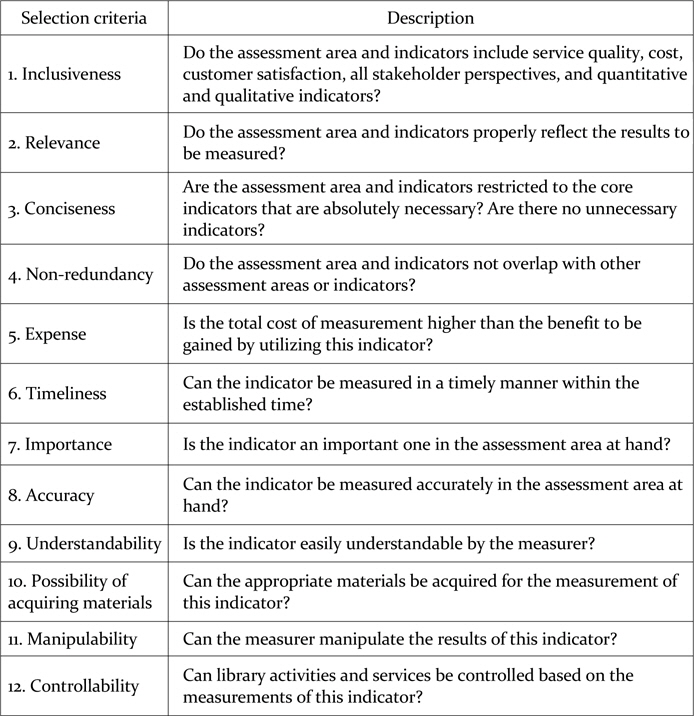
Indicator suitability review criteria
Numerous studies using suitability verification procedures in indicator development including Lee et al. (2011), KISTEP (2007), Lee et al. (2011), Choi et al. (2007) were examined. The common verification procedure details of these studies are shown below in Figure 1.
2. Research Framework and Procedure
2.1 Research Framework
This study applied DeLone and Mclean's IS success model (2002) and the Means-End Chain theory to establish an indicator development research frame with considerations for researchers' R&D life cycles and the work performance processes of research administrators.
DeLone and McLean, in consideration of the characteristics of information in the consumer behavior model, developed the specified e-commerce system success model (Wang, 2008), wherein quality is divided in to 'information quality', 'system quality' and 'service quality'. In their theoretical model, quality influences perceived value, and perceived value affects satisfaction, intent to reuse and loyalty, etc. The means-end chain is a theory wherein the user expresses his personal values himself, identifying in detail the relationship between the properties of the product/service (means) and the results gained by the user through these properties, along with the individual differences reinforced by these results.
This study assumed that the information customer value indicator framework of the researcher would vary over the entire R&D cycle, in research and information behavior, information needs, information searches, key information sources, the goal of information searching, obstacles and problem-solving methods. An indicator development model according to a researcher R&D life cycle was established as shown in Figure 2.
2.2 Procedure
[Table 5] Composition of the scale
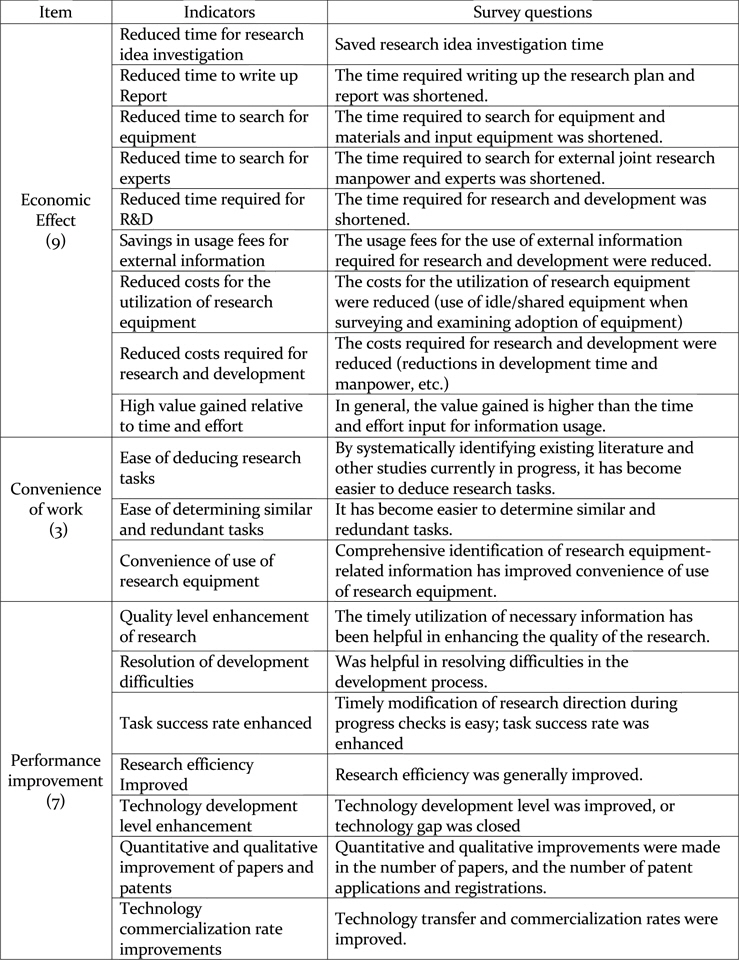
Composition of the scale
Indicator Development: As described above, based on existing literature regarding the verification of indicator development suitability, the study performed expert opinion surveys, in-depth user interviews and surveys to elaborate the indicators through suitability verification. The indicator elaboration process comprised a four-step verification process.
In step 1, opinion surveys were administered to the internal research team and external experts. The 108 previously developed items were modified and supplemented, giving a number of representative indicators. In step 2, in-depth interviews were conducted with 21 national R&D information service users, verifying the possibility of generalizing the indicators improved on in step 1. In step 3, a pre-test was administered to KISTI members who are national R&D information users. A web survey was administered to verify the validity of indicators and items. Lastly, using the results from steps 1 to 3 and expert opinions, the main study was performed to verify the suitability of the modified and improved indicators and to measure information customer values, in addition to analyzing information customer value that influences factors along with the degree of contribution. In the main study, a survey was administered on a group of 12,900 information users in the IT and BT fields. 302 researchers provided responses, and excluding careless responses, the number of subjects included in the final results was 288.
Composition of the Scale: The information customer value scale as deduced through prior research, the expert opinion survey, the in-depth user interview and the pre-test comprised a total of 28 items including information quality, service quality, usage environment, proliferation of the utilization of information and the intent to continue use as common elements applying to both researchers and research administrators. The scale for researchers included 19 items, including 9 items from economic effect, 3 items from convenience of work and 7 items from performance improvement benefits. The scale for research administrators comprised of 19 items, including 9 items from economic effect, 5 items from convenience of work and 5 items from performance improvement benefits.
3. Determinants of Information Customer Value
As a result of the factor analysis and reliability analysis performed in the study to deduce final information customer value indicators, 12 information customer value indicators as shown in Table 6 were grouped as a single factor: economic effect (6 items: reduced time for research idea investigation, reduced time to search for experts, reduced time required for R&D, savings in usage fees for external information, reduced costs for the utilization of research equipment, reduced R&D costs), convenience of work (1 item: convenience of use of research equipment) and performance improvement benefits (5items: resolution of difficulties in R&D, enhanced task success rate, quality level enhancement of research, quantitative and qualitative improvement of papers, patents and technology commercialization rate improvements).
[Table 6] Factor analysis result
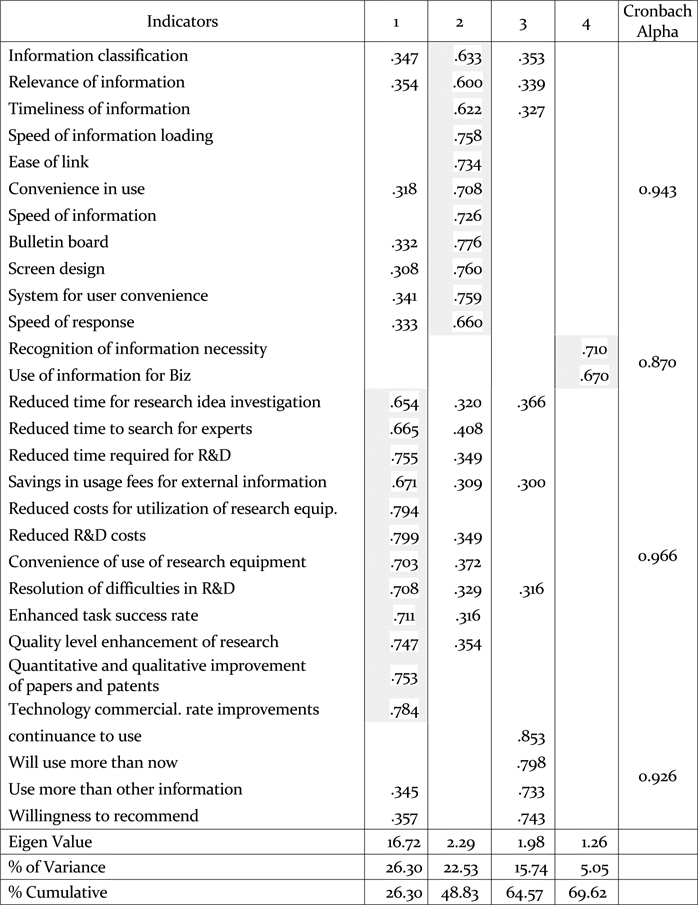
Factor analysis result
However, in the final expert meeting for selection of indicators, 2 indicators such as value gained versus effort and savings in time searching for equipment, tools and materials removed during factor analysis were added again. This was because the 'value gained versus effort' indicator was a direct measurement of customer value, and the 'savings in time searching for equipment, tools and materials' indicator was considered important, as the equipment search service was one of the key services of the National Technology Information Service (NTIS). As a result, the final number of information customer value indicators deduced by the study was 14. 2 additional items measuring quantitative effects were added.
IV. Measuring the Customer Value of Information Users
With the indicators screened and elaborated on, we measured the customer value of a national information service in Korea, named NTIS (National Technology Information Service). The result shows as follows:
[Table 7] Measuring the customer value of information
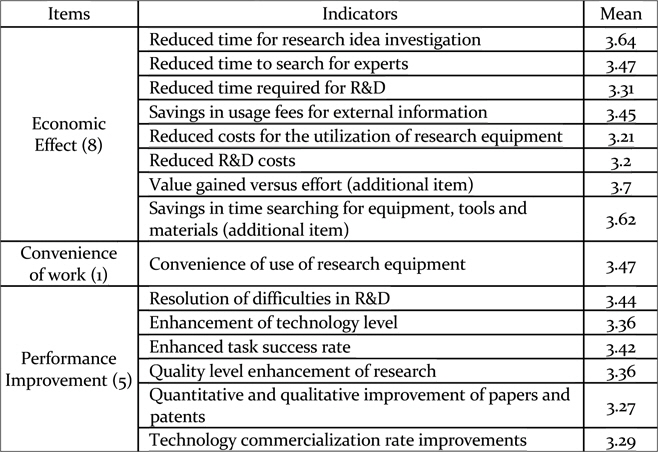
Measuring the customer value of information
Among the indicators, value gained versus effort (3.7), reduced time for research idea investigation (3.64) and savings in time searching for equipment, tools and materials (3.62) got the highest score, which means that the time-saving effect is the most important factor. On the other hand, technology commercialization rate improvements (3.29), quantitative and qualitative improvement of papers and patents (3.27), reduced costs for the utilization of research equipment (3.21) and reduced R&D costs (3.2) got the lowest scores.
This paper set forth to verify the suitability of previously developed indicators, to identify representative indicators among them, and to measure and assess the customer values of information users applying the indicators. For this purpose, using the 108 customer value indicators for R&D information users developed in 2012, this study conducted expert opinion surveys and in-depth interviews of heavy users, administering a pre-test and a main test to researchers in key industries such as IT and BT. Also, the study proposed means to maximize the information customer values of national R&D information, along with customer-oriented information marketing strategies.
The 14 customer value indicators developed in this research were the first ones applied in the R&D information services industry in Korea and may be the first, as well, all over the world.
However, as the customer value may quickly change in this ever changing environment, there is a need to improve them in a continuous way to make them more adaptable to the new environment.
In this regard, the organization should focus their services to the customers, which implies that the information marketing approach is needed. For that, all activities should be based on Customer Value Management. In other words, the management of the organization and the business units should be directed to enhance the customer value.
As the field study of this paper has been conducted on the information users in the field of national R&D, the results of the study has a limitation in its generalization. In fact, the customer value could be different by the industry. The information service has been free to use and the respondents were composed of only the actual users of the information. If the information had been provided at a cost, the results might be different. Considering this limitation, generalization needs a careful attention.
Future studies could be conducted in various industries in many countries to attain generalized results. In addition, it would be fruitful to connect the indicators to customer management activities. For example, the research on the customer value indicator to various consumer goods as well as to industrial goods needs further examination. As an example of a further study, it would be interesting to see a research model that identifies the factors that influence customer value.




